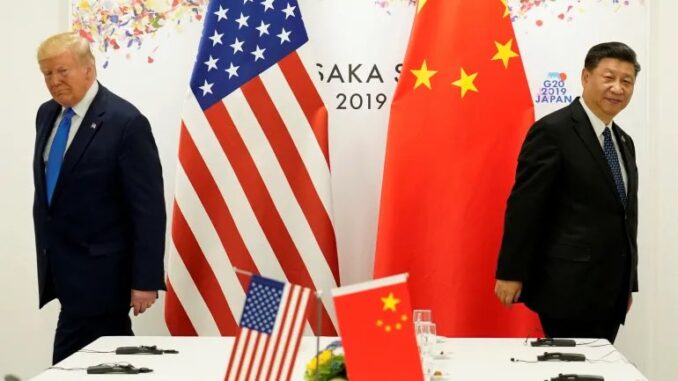
In a whirlwind 72 hours that has reshaped global supply chains, the United States has struck a series of deals positioning it as the undisputed architect of the critical minerals future. From Southeast Asian pacts to a landmark framework with China, today’s announcements signal the end of Beijing’s unchallenged dominance over rare earth elements (REEs)—the lifeblood of everything from F-35 fighter jets to Tesla batteries and AI data centers. As one viral X post aptly framed it, this isn’t just trade policy; it’s “tribute collection,” forcing nations to choose between access to the world’s largest consumer market or reliance on China’s processing monopoly.
While the post’s dramatic flair captures the geopolitical chess match, the underlying moves are very real, backed by fresh diplomatic breakthroughs and a U.S. strategy laser-focused on diversification. China has long held a stranglehold on the sector, controlling over 80% of global rare earth processing and 65% of production.
But escalating U.S. tariffs—threatening 100% duties on $300 billion in Chinese exports—prompted Beijing’s retaliatory threats to choke supplies of neodymium and other key REEs. The response? A rapid U.S.-led pivot to allies, culminating in today’s “framework” deal that defers China’s export bans until at least 2026.
This isn’t a truce; it’s a concession extracted through economic leverage, buying time for America to build an independent backbone.
The 72-Hour Checkmate: A Timeline of Breakthroughs
To understand the speed and scale of this shift, here’s a timeline of the pivotal events from the past three days, drawn from U.S. Trade Representative announcements and allied statements:
October 24: U.S.-Malaysia Mineral Pact
In Kuala Lumpur, the U.S. and Malaysia inked a reciprocal trade agreement ensuring no bans or quotas on critical minerals and REE exports to America. Malaysia is committed to “expedient development” of its REE resources, including joint ventures for mining and processing. This pact secures U.S. access to Malaysia’s growing ionic-clay deposits, bypassing Chinese controls and supporting ventures like DTEC MMT’s U.S.-aligned supply chain.
It’s a direct counter to China’s recent restrictions, with Malaysia’s policies remaining unchanged but now explicitly pro-U.S.
October 25: U.S.-Thailand Processing Deal
Building momentum, President Trump signed a separate agreement with Thailand focused on rare earth processing and trade. The deal emphasizes technology transfers and joint facilities, rerouting supply chains away from Beijing. Thailand, a rising hub for electronics manufacturing, pledges unrestricted access for U.S. firms to its mineral outputs, amplifying ASEAN’s role in “friendshoring.”
Malaysian Prime Minister Anwar Ibrahim hailed it as a model for regional cooperation, underscoring how these pacts “remind us that collaboration trumps confrontation.”
October 26: U.S.-China Framework Announced
The capstone: A preliminary trade framework with China, sketched out in high-level talks, pauses tariff escalations and delays Beijing’s expanded export controls on REEs, refined metals, and magnets (under Announcements No. 61 and 62 of 2025).
Treasury Secretary Scott Bessent confirmed the deal includes rare earth access in exchange for tariff relief, with final sign-off eyed for the November 1 APEC summit between Presidents Trump and Xi.
Hidden in the fine print: $13 billion in Australian processing investments, Cambodian extraction rights, and a revival of Japan’s 2010 strategy that slashed Chinese dependency by 30%—now scaled for $350 billion in U.S. AI infrastructure.
These moves have already jolted markets: U.S.-China trade, down from $758 billion in 2018 to $578 billion in 2024, is rerouting through ASEAN (up 20% in volume), eroding China’s market share for the first time in three decades.
A $20 billion “soybean freeze” serves as a stark reminder—China can pinch, but America can “inflict extinction” on export-dependent economies.
Secretary Chris Wright’s Vision: A “Rare Earth Crusade” with Clear Milestones
Energy Secretary Chris Wright laid out the administration’s blueprint in a must-watch October 25 interview with Larry Kudlow on Fox Business, framing it as an “all-of-government effort” to reclaim U.S. sovereignty in critical minerals.
Wright didn’t mince words: China’s “strategic dominance” has created a blackmail risk, as exposed in recent Wall Street Journal reporting, but the U.S. is countering with a full-spectrum assault on the supply chain—from mining to magnet fabrication.
Key takeaways from the interview:
Partnerships as the Engine: Wright emphasized collaborations with “small miners, big miners, processing companies, and manufacturers.” Larger firms are sharing tech to fast-track ramp-ups, while recycling old devices and tapping inventories provide short-term buffers. “Friendshoring” from allies like Australia and Japan is immediate, with the recent U.S.-Japan MoU as Exhibit A.
Overcoming Barriers: Permitting “lawfare” and legal hurdles—like the 29-year saga for Arizona’s Resolution Copper mine—are top targets. Reforms will streamline approvals, unlocking resources in California (current production hub), Nevada, Utah, Arizona, and Idaho.
Opening New Frontiers: The Arctic National Wildlife Refuge (ANWR) in Alaska is now fair game, unleashing “American entrepreneurship” across the North Slope. This ties into broader energy dominance, including the Ambler Road Project for AI-critical minerals.
|
Milestone
|
Timeline
|
Key Actions
|
|---|---|---|
|
Short-Term Relief
|
Immediate–6 Months
|
Friendshoring deals (e.g., Malaysia, Thailand); recycling drives; inventory drawdowns; $5B critical minerals fund for allied mining/processing.
energynewsbeat.co
|
|
Better Position
|
12 Months
|
Domestic permitting reforms; initial refineries online in Texas/Nevada; reduce import reliance to 70–80%; ANWR exploration ramps up.
|
|
Massive Gains
|
24 Months
|
Full supply chain self-sufficiency (mining to magnets); U.S. reserves hit 30M tons; processing capacity at 50% non-Chinese; “Operation Warp Speed” for REEs yields new facilities.
|
As Wright told Kudlow, “We’re moving forward every day,” but breaking China’s grip “will take time” given Beijing’s decades-long head start.
The November Trump-Xi meeting? A “rare earth crusade” checkpoint, where access concessions could avert full-blown escalation.
Echoes from Energy News Beat: China’s Grip Slipping
Energy News Beat’s recent coverage underscores how these events fit a larger pattern. In “China to Delay the Rare Earth and Critical Minerals Bans” (published today), we detailed Beijing’s backpedal as a “pragmatic truce” amid U.S. tariff threats, with only 25% of Chinese export licenses approved—halting lines from Detroit to Dortmund.
The piece highlights mutual dependencies: China needs REE export revenue, and disruptions could boomerang on its economy.”Europe is the Biggest Loser in US-China Rare Earth Wars” (Oct 18) warns of the EU’s 98% reliance on China, with the bloc’s Critical Raw Materials Act falling short—risking industrial sidelining as U.S.-allied chains solidify.
Meanwhile, “Why the Critical Mineral Ban from China Is Great for the United States” (Oct 13) flips the script: Beijing’s overreach accelerates U.S. diversification, proving China controls processing, not raw deposits.
The U.S.-Japan deal spotlights private-sector muscle: REAlloys Inc.’s MoU with JOGMEC licenses magnet tech for Ohio facilities, securing scandium/yttrium offtakes while countering China’s 80% refining edge.
This aligns with Trump’s October 22 Australia framework ($3B+ in joint investments) and a new $5B U.S. fund for mineral security.
As “Global Rare Earth Market Poised for Transformation” predicts, China’s share could plummet by 2035 via new Western mines.
The Bigger Picture: Empire by Subscription
The X post’s core insight rings true: Globalization isn’t dead—it’s been “privatized.”
Nations now subscribe via loyalty: Allies get exemptions (just 4% tariffs), while adversaries face 63% walls. This “gated API” model—leveraging dollars, SWIFT, and export licenses—turns markets into weapons. For REEs, it means American boots in Asian facilities, Taiwan’s security bolstered, and AI dominance locked in.
Challenges remain: Building refineries takes years, and Europe’s paralysis could fracture Western unity. But with Wright’s roadmap and Trump’s deal-making, the U.S. isn’t just playing defense—it’s scripting the endgame. As the post concludes, “America gets the future.” Stay tuned to Energy News Beat for updates from APEC and beyond.
Got Questions on investing in oil and gas? Or do you have a Tax Burden in 2025?
Crude Oil, LNG, Jet Fuel price quote
ENB Top News
ENB
Energy Dashboard
ENB Podcast
ENB Substack





